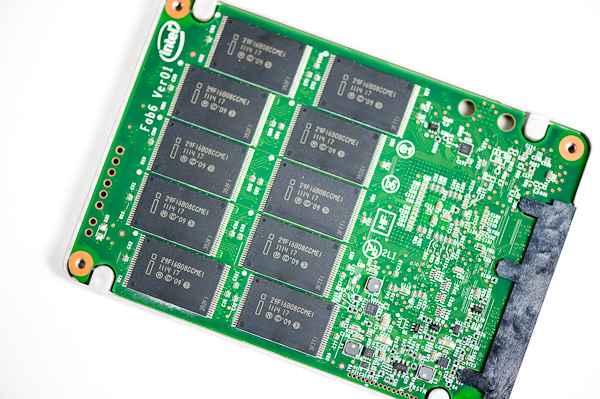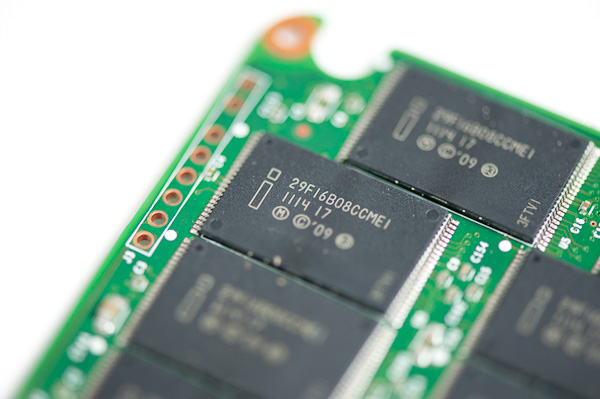The Intel SSD 710 (200GB) Review
by Anand Lal Shimpi on September 30, 2011 8:53 PM EST- Posted in
- Storage
- SSDs
- Intel
- Intel SSD 710
Total Bytes Written & Spare Area

90K p/e cycles seems a bit high and I can't find any Intel documentation that actually quotes that number, it's just what I heard at the 710 briefing in San Francisco. Luckily Intel has another metric it likes to use: total bytes written.
You don't get TBW for client drives, but for enterprise drives Intel will tell you exactly how many tera or petabytes of random 4KB or 8KB data you can write to the drive. These values are "up to" of course as actual lifespan will depend on the specific workloads.
| Intel SSD Endurance Comparison | |||||||
| X25-E 32GB | X25-E 64GB | 710 100GB | 710 200GB | 710 300GB | |||
| 4KB Random Writes | 1.0 PB | 2.0 PB | 500 TB | 1.0 PB | 1.1 PB | ||
| w/ +20% Spare Area | - | - | 900 TB | 1.5 PB | 1.5 PB | ||
Doing the math these values work out to be about 5K writes per cell (~5243), however that's assuming no write amplification. Performing a 100% random write across all LBAs for a full petabyte of data is going to generate some serious write amplification. The controller in the 710 tends to see write amplification of around 12x for 4KB random writes, which would put the rated cycle count at just under 63,000.
There's just one problem. The 200GB 710 I'm basing these calculations on doesn't actually have 200GB of NAND on-board, it has 320GB.
Opening up the 710 that Intel sent me I found a total of 20 NAND packages on-board. This isn't surprising as Intel's controllers have always supported 10 parallel NAND channels, in this case the 710 uses two packages per channel and interleaves requests to them. Each NAND package however has 128Gbit (16GBytes) of NAND inside in the form of 2 x 8GB 25nm MLC-HET die. Multiply all of that out and you get 320GB of NAND inside this 200GB drive.
Of course 200GB is defined as 200,000,000,000,000 bits, so actual binary storage capacity is 186.3GiB. This is absolutely insane: over 41% of the NAND on the 710's PCB is set aside as spare area. We have never reviewed an SSD with anywhere near this much spare area before.
If we run the p/e count with 320GB as the actual amount of NAND available, it works out to be just under 40K p/e cycles per cell. The significant spare area on the 710 increases the drive's projected lifespan by 55%! Intel even recommends setting aside another 20% of the drive if you need a longer lifespan. An extra 20% spare area will give you another 50% increase in total bytes written. Tinkering with spare area just helps reduce write amplification, it doesn't magically make the NAND cells last longer.
If we believe Intel's specifications, MLC-HET actually sounds pretty decent. You get endurance in the realm of the X25-E but at significantly lower cost and with more reasonable capacity options.
Thankfully we don't need to just take Intel's word, we can measure ourselves. For the past couple of years Intel has included a couple of counters in the SMART data of its SSDs. SMART attribute E2h gives you an accurate count of how much wear your current workload is putting on the drive's NAND. To measure all you need to do is reset the workload timer (E4h) and run your workload on the drive for at least 60 minutes. Afterwards, take the raw value in E2h, divide by 1024 and you get the percentage of wear your workload put on the drive's NAND. I used smartmontools to reset E4h before running a 60 minute loop of our SQL benchmarks on the drive, simulating about a day of our stats DB workload.
Once the workloads finished looping I measured 0.0145% wear on the drive for a day of our stats DB workload. That works out to be 5.3% of wear per year or around 18.9 years before the NAND is done for. I'd be able to find more storage in my pocket before the 710 died due to NAND wear running our stats DB.
For comparison I ran the same test on an Intel SSD 320 and ended up with a much shorter 4.6 year lifespan. Our stats DB does much more than just these two tasks however - chances are we'd see failure much sooner than 4.6 years on the 320. An even heavier workload would quickly favor the 710's MLC-HET NAND.
But what about performance? SLC write speeds are much higher than MLC, but Intel's MLC performance has come a long way since the old X25-E. Let's get to the benchmarks.
The Test
We're still building up our Enterprise Bench data so forgive the lack of comparison data here. We included a number of consumer drives simply as a reference point.
| CPU |
Intel Core i7 2600K running at 3.4GHz (Turbo & EIST Disabled) |
| Motherboard: |
Intel H67 Motherboard |
| Chipset: |
Intel H67 |
| Chipset Drivers: |
Intel 9.1.1.1015 + Intel RST 10.2 |
| Memory: | Qimonda DDR3-1333 4 x 1GB (7-7-7-20) |
| Video Card: | eVGA GeForce GTX 285 |
| Video Drivers: | NVIDIA ForceWare 190.38 64-bit |
| Desktop Resolution: | 1920 x 1200 |
| OS: | Windows 7 x64 |













68 Comments
View All Comments
inplainview - Saturday, October 1, 2011 - link
Useless toys? Is this coming from someone that can't afford Apple's offerings or someone who hasn't figured out that Apple is in the mainstream of consumer offerings and mentioning them is this consumer space is quite appropriate considering Apple's influence. You have proven yourself to be myopic and petty.Stas - Sunday, October 2, 2011 - link
umadbro? Everything Apple sucks :Dgevorg - Saturday, October 1, 2011 - link
At least there is no Top 100 iPhone apps here. :)web2dot0 - Friday, September 30, 2011 - link
Unfortunately, that's what people want to read nowdays. Anand is just targeting the mainstream. Otherwise, how will he get all the pageviews? It's a business afterall. Let's not be naive. He doesn't choose his articles to write about by random. There's always a reason to the madness. He's just trying to stay (slightly) ahead of the curve. Too hard out, and it'll become irrelevant.Just wish the team stops writing so many editorial news reporting and focuses more on technical analysis like the ones above. The site is slowly becoming more and more corporate and with time, it will lose it's edge.
Anyways, it's not like other sites are that much better. There's always room for improvement ....
taltamir - Saturday, October 1, 2011 - link
Apple has single digit market-share. This is as far from mainstream as possible.B3an - Saturday, October 1, 2011 - link
....Yeah in computers but thats it. Apple are the largest consumer tech company on the planet, they now make more money than Microsoft. Apple pretty much have a monopoly on MP3 players and online music. They have the single best selling phone, the best selling tablet, and are gaining PC market share. For tech stuff you cant get more mainstream than Apple. There useless devices dont belong on serious sites like this IMO, they belong on dumbed down crap like Engadget.inplainview - Saturday, October 1, 2011 - link
How many of you would be willing to financially support this site so that you can get your truckload of geek? Most likely zero to none. This site is supported via page hits which means that the authors have to write about stuff that most of the basement dwellers here aren't interested in. However, as someone who actually goes out into the sun, knows what women look like, smell like, taste like (figure it out), and realize that there is a world outside of sitting in front of a keyboard and bitching about how this site is not this and that, I can appreciate the work put in. Some of you people are simply whiners and pathetic.Stas - Sunday, October 2, 2011 - link
Apple unofficially owns EngadgetKPOM - Saturday, October 1, 2011 - link
In the US, Apple has the third largest share of the PC market.http://arstechnica.com/apple/news/2011/07/apple-no...
It's lower worldwide, but Apple is definitely a mainstream PC manufacturer.
http://osxdaily.com/2011/03/18/mac-market-share-ar...
Penti - Saturday, October 1, 2011 - link
Anandtech is far from and far more then just a gadget site. Times change and you have to keep up with that to. So of course the focus changes, it's not all about the baddest mainstream overclocking mainboards and high-end gamer gpus any more, things have changed and people come here because it's not just fluff but also digs through down in the hardware/product. You will have more smartphones, notebooks and so on the gpu wars itself won't get you a lot of readers. You will have more enterprise topics and so on. Computing has changed. It's not really about gaming any more and that market has changed.